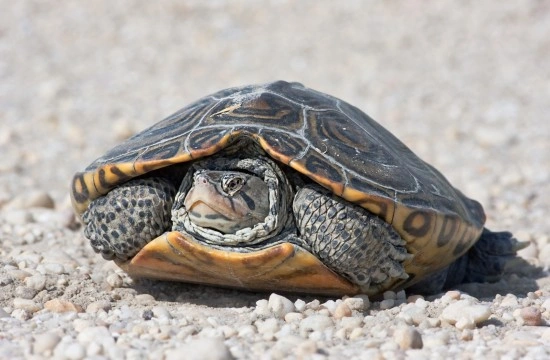
Diamondback Terrapins as Pets
The diamond back terrapin (Malachlemys terrapin) is a small to medium sized terrapin originating from a range of geographical locations across their native range of the USA. There are seven subspecies currently recognised and each is named after the regions they inhabit. These include the Texan diamond back (M.t.littoralis), the Mangrove diamond back (M.t.rhizophorarum) and the Northern diamond back (M.t.terrapin), which is generally the most commonly seen subspecies in captive collections in Europe. Growing to a size of around 18cm in females and 13cm in males, the diamond back is an especially pretty terrapin with different subspecies showing slight variations in their pale silvery or cream skin, delicately patterned with black or grey spots or freckles and brown, green, orange or grey circle or swirl-type markings on each of the scutes of their carapace (upper shell). Sadly, the diamond back has suffered a severe decline in wild population numbers in recent decades due partly to the loss of their costal and salt marsh habitats but also due to demand from American and European restaurants as a popular delicacy. Although they are listed as ‘near threatened’ on the IUCN (International Union for Conservation of Nature) red list of endangered species, there are still relatively few conservation initiatives in place to preserve their natural habitats, and so several dedicated captive collections have now been established by conservation charities and private collections in order to establish breeding programmes for these terrapins and work towards restoring subspecies population numbers.
A particular aspect of keeping these attractive little terrapins successfully as pets that should be considered is that ideally they need to be kept in brackish (salt water) set ups. The level of salt present in water is measured in a unit known as specific gravity, and is measured using a device called a refractometer or hydrometer – an invaluable piece of equipment available quite cheaply from most specialist aquarium supply shops that stock marine fish. Although pre-mixed brackish water solutions can be often be purchased in large plastic drums or jerry cans from such outlets, it generally works out cheaper to obtain RO (reverse osmosis) or distilled water – usually costing in the region of £5 or less for 20 litres, and mix your own salt water using one of the commercially available purified salts designed for marine aquariums. The water should be heated to a temperature of around 76°F and the salt mixture gradually added every few hours until a salinity of 1.012-0.015 is achieved. This brackish water should then be allowed to ‘settle’ for at least 48 hours to ensure the salt content is completely dissolved before terrapins are added to the tank.
Some keepers have had success in keeping their diamond backs in fresh (non-salt) set ups but only when the water quality in these cases is kept scrupulously clean, with regular water changes and powerful filters. Fresh (non-salinated) water from the tap should first be treated using a reptile specific dechlorinator treatment to remove traces of heavy metals and other elements, and large external filters with several layers of mechanical and biological filtration media will need to be used in order to keep the water well circulated and prevent a harmful build-up of ammonia and other waste compounds. Even with good quality filtration, twice weekly water changes to remove and replace 30-50% of the total water volume are essential to keep bacterial loads to a minimum and maintain a stable water chemistry. Failure to do so will quickly result in these terrapins developing disorders of the skin and shell including ulcers, shell rot and sloughing off of scutes (the large scales that form the top of the shell) as they seem particularly prone to bacterial and fungal skin diseases.
Whether you chose to use fresh or salt water, diamond back terrapins are active and curious little characters and do require a fairly large tank to do well – a modified 4 foot long x 12 inch deep aquarium will comfortably house a pair of adults, with a water depth of 18-20 inches being ideal. Large pebbles (no less than 1 inch in size) can be used to cover the bottom of the tank and the addition of hardy live aquarium plants such as Elodea or Anubias will create a more appealing and naturalistic appearance. Terrapins should always have access to a dry land area that is easily accessible via a gentle slope from the water – this is most easily created by building up a raised bed of large pebbles or sand at one end of the tank. A full spectrum UV and heat bulb such as combined mercury bulb should be directed onto this area for basking purposes for 10-12 hours per day – this must be kept at a safe distance of no less than 18 inches from both the terrapins and the water in order to avoid possible risks of burns or the bulb shattering should it accidently get splashed.



